
The Basics:
- For ages 6 and up (publisher suggests 15+)
- For 1 to 4 players
- Approximately 90 minutes to complete (per scenario)
Geek Skills:
- Active Listening & Communication
- Counting & Math
- Logical & Critical Decision Making
- Reading
- Pattern/Color Matching
- Strategy & Tactics
- Risk vs. Reward
- Visuospatial Skills
- Cooperative & Team Play
Learning Curve:
- Child – Easy
- Adult – Easy
Theme & Narrative:
- Bust some ghosts to keep the world safe
Endorsements:
- Gamer Geek approved!
- Parent Geek approved!
- Child Geek approved!
Overview
Some believe that ghosts exist, while many others remain skeptical. Still, few of us will venture into an abandoned house or graveyard at night. What are we afraid of? In 1984, four scientists decided to capture our fears once and for all, but there was one unforeseen problem. Once you capture ghosts and fears in a box, many more manifest to take its place.
Ghostbusters: The Board Game, designed by Mataio Wilson, Adam Sblendorio, Matt Hyra, and published by Cryptozoic Entertainment, is comprised of 4 Ghostbuster miniatures, 3 Ghost Boss miniatures, 20 Galloping Ghouls miniatures, 12 Gruesome Twosomes miniatures, 8 Boogaloo Manifestations miniatures, 10 double-sided tiles, 1 Ecto-1 tile, 1 Ecto-1 miniature, 20 Stream tokens (5 tokens per Ghostbuster), 1 Spirit World tile, 5 Gate tokens, Slime tokens, 1 PKE Meter board, 1 standard eight-sided die, 4 standard six-sided die, 1 customized six-sided die (shows Gate symbols), 4 Player cards, and 6 Ghost cards. The components are top-notch, with thick tiles, thick cards, and detailed sculpted miniatures. Even the illustrations are excellent, immersing the player into the exciting and lucrative career field of ghost busting.
Note: We played the Ghostbusters: The Board Game “Mass Hysteria” deluxe edition. This was part of a limited release of the board game’s Kickstarter campaign. The contents of the game are the same as the normal edition game except for a few additional figures, tiles, and dice. In all cases, the game play is the same. All we have is a few more bits, but no additional game play that would suggest the games are vastly different. Since Ghostbusters: The Board Game is easily available (and the deluxe is not), we decided to review the game from the perspective of the more accessible game, allowing you to grab it if you like what you read.
Equipment Check
Ghostbusters: The Board Game comes in a big box, but players will only use bits and pieces of it. What is used is determined by the scenarios, cards the describe the story, the objective, and what game components will be used. Listed here is a summary of the major game components.
Player Cards
Player cards describe the Ghostbuster and display their current level of experience. In this game, ghost busting takes skill, and the more you have, the better you are at it. As players continue to play the game, be it during a single session or during campaign play (several linked scenarios in a row), the Ghostbuster will improve, obtain new skills, and in general become a bad ass. Which is good because many of the ghosts the Ghostbusters will encounter are bad…really bad. The more ghosts you catch and spirit gates you close, the better “buster” you become.
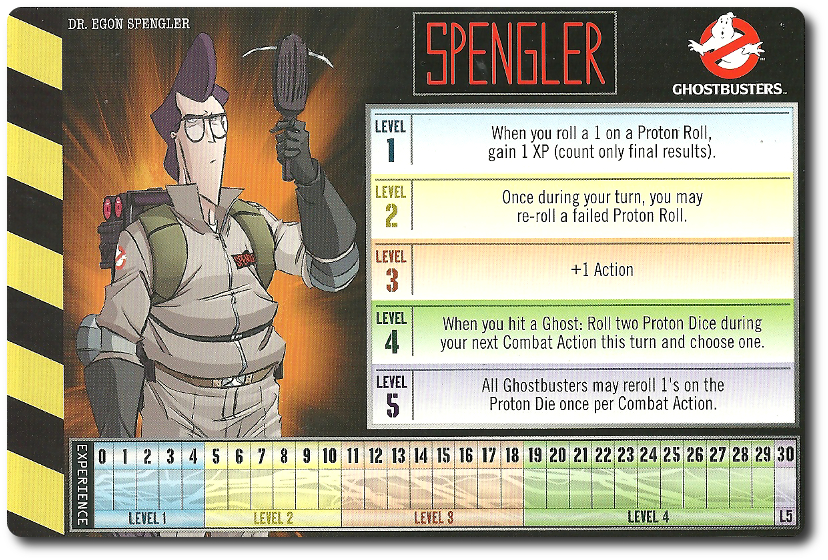
Ghost Cards
The Ghost cards describes a specific ghost class, which also includes information on how hard it is to capture, what it does if it gets scared, and how it moves. It also details any special characteristics that spell trouble for the Ghostbusters. Each Ghost card will either represent a large number of miniatures or only 1, depending on what the ghost miniature is. For example, common ghosts will all share the same Ghost card, while a boss ghost will have their own.

Tiles
The tiles in the game are double-sided and portray streets, buildings, and parks. When put together, they form the playing area that the Ghostbusters will be traversing and the ghosts will be haunting. On the tiles are obstacles that will block movement, line or sight, or both. This makes the landscape something of an urban battleground, where the Ghostbusters must traverse the obstacles in order to get to their objective. Sometimes that means breaking down doors to find a shortcut and sometimes that means taking the long way around.
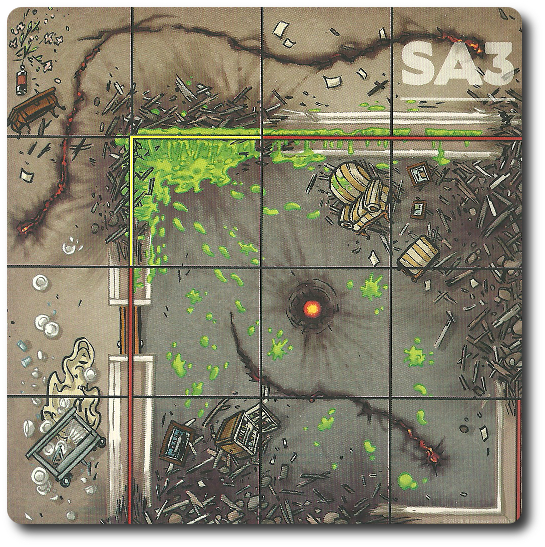
Ecto-1
Ecto-1 is the workhorse of the Ghostbuster operation. It’s a mobile research lab, contains tactical and communication equipment, sensors, arrays, and best of all, a portable containment grid. Players can deposit captured ghosts when they are adjacent to the Ecto-1 miniature, but when they aren’t flushing their traps, they can jump in the car and travel around faster than normal by placing their Player miniatures on the Ecto-1 tile. Which is good, because there are some parts of town you don’t want to be walking in.
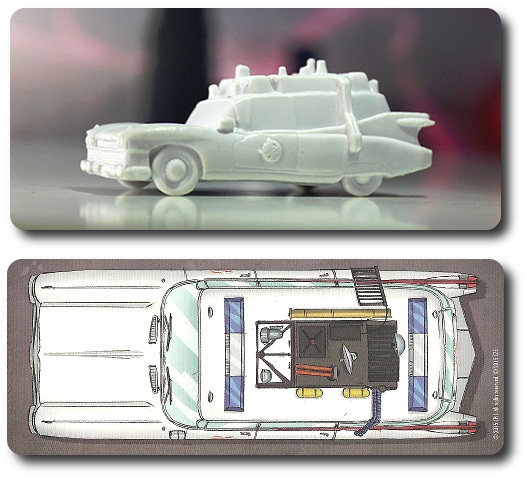
Dice
The dice in the game are used like most other dice. They are rolled, a value is shown, and that value determines if something is successful or not. Or, if you prefer, is something bad happens or not. The only die really worth mentioning is the custom six-sided die that displays spirit gate symbols. This die and its rolled value are used differently in the game depending on the scenario, but in general, the die determines random entry points for ghosts. If the Ghostbusters have closed spirit gates to the spirit realm, they make it all the more harder for ghosts to get to our world.
Miniatures
Finally we come to the miniatures. Each Ghostbuster team member is represented by a miniature, as are the ghosts plaguing the area the Ghostbusters are currently in. Facing does not matter when it comes to the miniatures, as each miniature can see around them and target whatever they have a line of sight on. In almost all cases, miniatures represent the current location of the Ghostbuster or ghost and its proximity to others. But don’t let that stop you from worrying. Distance is a very real and sometimes challenging obstacle. Players will need to decide if staying together is the best course of action or splitting up is the way to go. Either way, Ghostbusters and ghosts all move independently. Size doesn’t matter, but it does suggest how difficult it will be to catch a spirit. The Stay Puft Marshmallow Man, easily the largest miniature in the game, takes at least 10 streams from a combined force of 4 Ghostbusters to take down. Now that’s a serious threat.
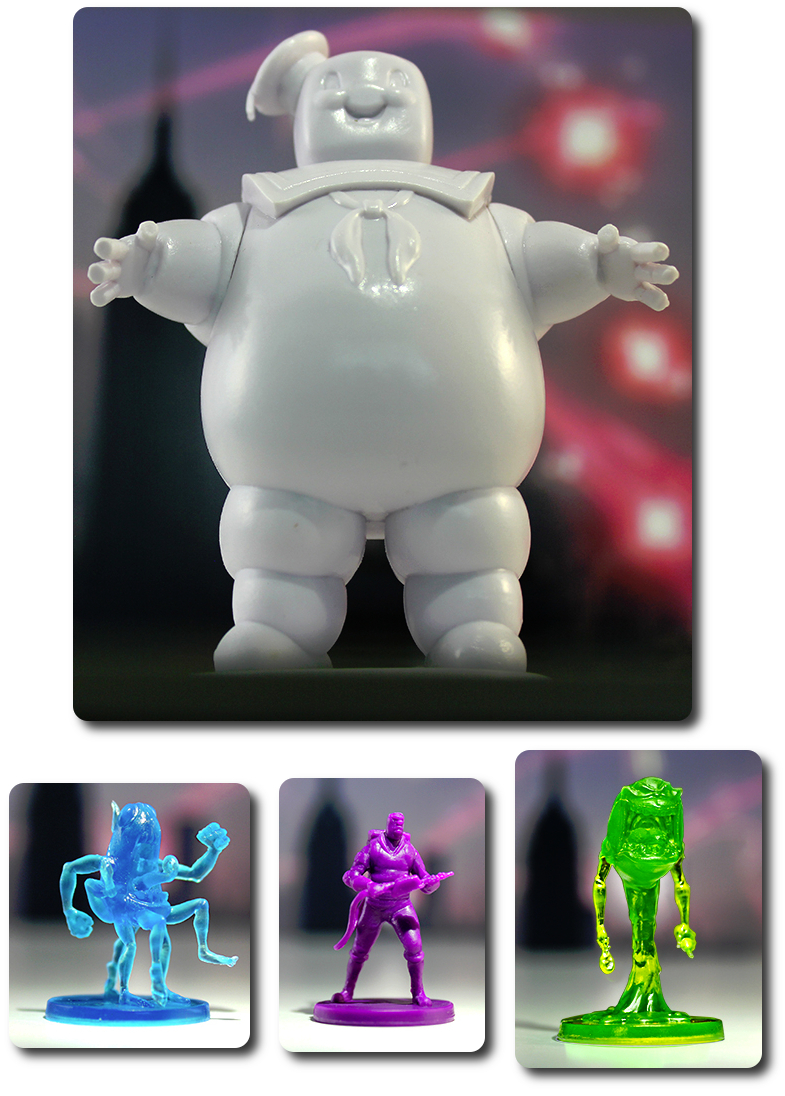
WE GOT ONE!!!
To set up the game, first give each player 1 Ghostbuster miniature and its corresponding Player card. The game must be played with 4 Ghostbusters, so if there are not 4 players, one or more players will need to play an additional Ghostbuster or the extra non-player Ghostbuster can be controlled by the group.
Second, select a scenario to play. Any scenario can be selected, but if the goal is to play a campaign (a series of linked scenarios), find the first scenario in the campaign. Regardless, follow the instructions on the scenario to build the playing area, select the right number and type of ghost miniatures, place the gates, and all the miniatures in their starting position.
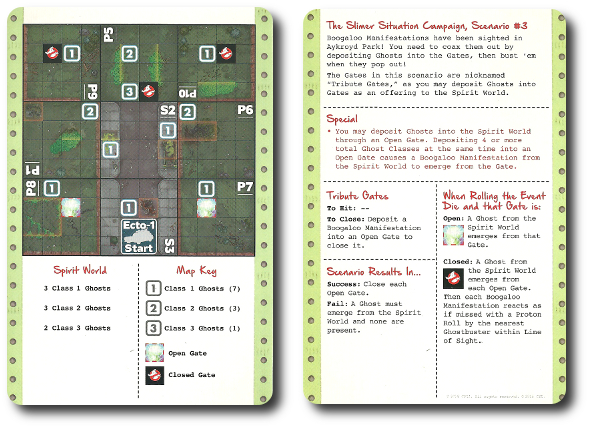
Scenarios describes how the game should be set up and how the game interacts with players
Third, place the PKE meter and Ecto-1 tile to one side of the game playing area, along with the dice. Everything else can go back in the box.
That’s it for game set up. Determine which player will be the “First Player” and begin. Time to bust some ghosts.
We’ve Got the Tools; We’ve Got the Talent!
Ghostbusters: The Board Game is played in rounds and turns. Depending on the scenario, there might be a specific number of rounds or none. In any case, each player has a single turn, starting with the “First Player” Ghostbuster and continuing clockwise. After the Ghostbusters have taken their turn, the ghosts take theirs, but they also most likely reacted somewhat during the Ghostbuster turns. A single round of game play is summarized here.
Ghostbusters’ Turn
A player’s turn is broken down into 2 steps.
Step 1: Spend Actions and Maneuvers
Each player will have 2 actions by default, but if they get slimed, they will not be able to move as quickly and have a reduced number of actions as a result. Each of the following is considered 1 action. The player can take them in any order and repeat them, as well. As the Ghostbuster becomes more skilled, they will gain more actions.
- Move: move the Ghostbuster miniature 1 or 2 spaces (diagonally and orthogonally)
- Drive: if the Ghostbuster miniature is located in Ecto-1, move the Ecto-1 miniature up to 6 spaces orthogonally)
- Flush Trap: deposit any trapped ghosts into the containment grid when adjacent to the Ecto-1 miniature
- Clean Up: remove 1 Slime token from an adjacent Ghostbuster
- Hit It!: engage in combat with a ghost or target a spirit gate
Maneuvers are not actions, per se. They do not take the place of actions and they do not count as actions, but they are resolved just the same. Anytime during the player’s turn, be it before, during, or after taking actions, the player can use a maneuver.
- Transfer Trap: move 1 trapped Ghost miniature from the Player card to the Player card belonging to an adjacent Ghostbuster miniature
- Use Ecto-1: either jump in or jump out of Ecto-1 miniature and tile from one of its 4 sides.
Optionally, the player can decide to take no actions on their turn and remove 1 Slime token.
Step 2: Resolve End of Turn Scenario Effects
Once a player has completed their turn, the scenario might require the players do something in the game. The scenario will detail what, if anything, needs to happen. Then the next Ghostbuster takes their turn and so on until all Ghostbusters have completed their turn for the round.
Ghosts’ Turn
Ghosts don’t take specific actions until specific events trigger. For example, the end of player’s turn, the results of combat, or the end of the round. The scenario card will detail anything specific, including any end of round events.
When all effects are resolved, the Event die is rolled. The Event die is the customized six-sided die that has the spirit gate symbols on it. The Event die is rolled and the results are compared to what the scenario card states. In almost all cases, the Event die indicates from which open spirit gate ghosts will emerge. In the worst of cases, it will move the world that much closer to doom or send all the ghosts in a frenzy, which is especially irritating.
Once the round is over, a new round begins unless the scenario’s endgame condition has been met.
He Slimed Me
Combat and movement in the game is pretty straight forward. Movement is based on spaces on the tiles, with each space indicating a single point in movement. Obstacles can get in the way, forcing the players to move around and take the long way to get to their destination. Obstacles can also include Ghosts miniatures, which are, understandably, nothing a Ghostbuster wants to walk through.
Combat is just as easy. Players use the concept of line of sight to determine if they have an unobstructed point-of-view of their target. They then attempt to hit the ghost using their Proton Streams. A player can attach several streams to a single target and can get help from others. Once the ghost has enough streams on it, it’s captured and removed from the game board, placed on the Player card that used the most streams.
Weaker ghosts can be captured by a single Ghostbuster without much issue. Larger and tougher ghosts will require the players to work together as a team to bring down the nightmares that get through the spirit gates. If the Ghostbuster isn’t targeting a ghost (or worse), they can target the spirit gates and close them. This is the standard secondary objective for every Ghostbuster. Spirit gates are like a hole in the dam. If they aren’t plugged, they will continue to leak. In this case, they don’t drip water, but ghosts.
When combined, movement and combat are two important tactical components. A Ghostbuster can attack a ghost at a distance, but if the player should move out of range or the ghost should seek cover, the streams attached become disengaged. As such, players will have to move around and outflank ghostly opponents. Sometimes they will even have to stay in front or surround a ghost to ensure they don’t lose their stream.
If a Ghostbuster should miss a ghost or hit it, it will react in different ways. The Ghost card describes everything that happens when the ghost is hit or merely grazed. Sometimes the ghosts run around crazy, sometimes they do something very specific to the person who tried to hurt them.
Saving the Day or the End of Days
As the game continues, the players will fight their way to specific destinations, close spirit gates, and attempt to complete the scenario’s goal. If they do so, the players win the game. If not, the world as we know it ends poorly. In most cases, players will lose the scenario if a ghost needs to come through an open spirit gate, but there are no more ghosts in the Spirit World to make the trip. This means, thematically speaking, the Spirit World and our world crash into each other, merging to become something like jello or your jam of choice. Either way, not good.
If the players are working their way through a campaign, the next scenario is selected, and the game is reset. Experience points earned during the last scenario remain.
To learn more about Ghostbusters: The Board Game, visit the game’s web page.
Final Word
The Child Geeks loved this game. Not only did they find the rules easy to understand, but they had no issue working together as a team. It might have helped that all our Child Geeks had watched the Ghostbuster movie, but I doubt it. If nothing else, the movie brought the game to life even more, but did little to help them win. According to one Child Geek, “I really like this game. I like that we get to fight ghosts, drive the car, and get slimed!” Another Child Geek said, “You have to work together as a team, but you can go off on your own, too. The game doesn’t mind what you do as long as you are having fun.” When all the ghosts were busted (or the world ended), the Child Geeks voted and everyone approved the game. The Child Geeks weren’t afraid of no ghost, but they were afraid of not being able to play the game again.
Note: Since Ghostbusters: The Board Game is a cooperative experience, Child Geeks much younger than expected were able to play and enjoy the experience. The older players had to lend a hand in helping keep track of rules and experience points, but that was it. The youngest of our Child Geeks busted as many ghosts as their older team members, demonstrating that the game was playable by a much wider audience than originally expected.
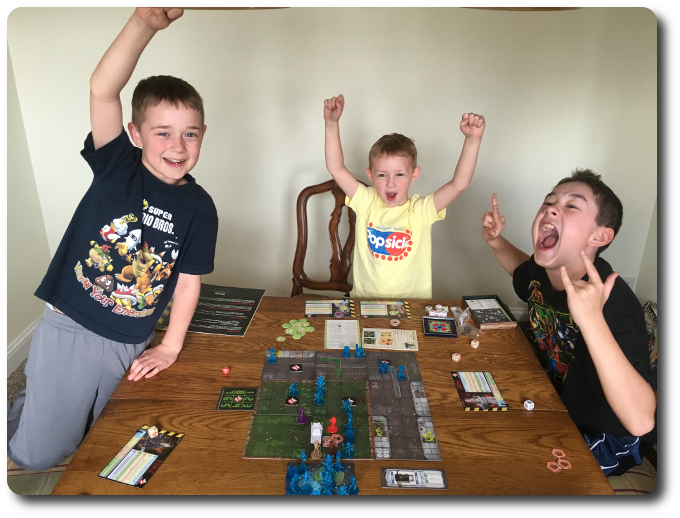
With the last spirit gate closed, all of my little Ghostbusters shouted, “WE AIN’T AFRAID OF NO GHOST!”
The Parent Geeks also enjoyed the game and for several different reasons. To begin with, all the Parent Geeks greatly appreciated the game from a nostalgic level. According to one Parent Geek, “I saw the movie and thought it was OK, but seeing all these ghosts of giant marshmallow man really makes me smile.” Second, the game play was easy to understand, easy to follow, and easy to enjoy. As one Parent Geek put it, “The game is easy to learn and gives the players a lot of control without making it complicated. I really like games that open its world to you without requiring you to be an expert on everything.” The Parent Geeks found the game to be enjoyable with their peers and their family. One Parent Geeks even tried the game solo and reported back it was an “awesome time”. When all the votes were in, the Parent Geeks voted to approve the game.
The Gamer Geeks were just as nostalgic as the Parent Geeks and just as giddy about the components. They were not as enthused with the game play. According to one Gamer Geek, “The game is fine, but nothing special other than it’s about the Ghostbusters. Don’t get me wrong, it’s a solid game, but the game play itself is pretty run-of-the mill.” Which is to say, the Gamer Geeks didn’t think the game play was good or bad, challenging or easy. It was just – well – “obvious and predictable”. Another Gamer Geek said, “While the game play is familiar, I think the game’s real charm is what it contains and what it is about. I’d play this game again and again just because it’s about the Ghostbusters. And the miniatures are great, too.” A few of the Gamer Geeks found the game to be a bit shallow when it came to depth of play, but none of them suggested they disliked the game. Grumbling and negative comments aside, all the Gamer Geeks voted to approve Ghostbusters: The Board Game.
Putting my own nostalgia and fandom aside for a moment so I might think objectively, Ghostbusters: The Board Game is a solid Cooperative game, but that’s it. Hunting down ghosts before a certain threat level is reached is thematic, but isn’t revolutionary. The game is a good one, but for those who have played Cooperative games before, they will quickly find that Ghostbusters: The Board Game is all about busting ghosts, but not about busting the mold. What elevates this game above and beyond the other Cooperative games is its theme and miniatures. The game was designed for Ghostbuster fans and it delivered. It just also so happens to be a well designed Cooperative game that isn’t doing anything new. Some might call that a blemish but I disagree. What makes a game a good one is that you enjoy playing it and everyone we played the game with enjoyed themselves immensely.
At the heart of the game are the scenarios. Does that suggest that the game dies when the players have completed all the scenarios in the game? Oh, goodness, no. Ghostbusters: The Board Game can be played for a very, very long time, but only if the players are willing to inject some creative energy. After the scenarios are completed, the game can continue with player-created scenarios and new objectives. Everything in the game is reusable and can be molded to fit any story the players can think of. Again, it just takes some imagination. Fans have created their own scenarios and it takes less than 10 minutes to think of a story, a nemesis, and a layout to create your own. As a result, Ghostbusters: The Board Game is a game you buy once and can play forever. Like the ghosts the game contains, the game never dies.
As previously mentioned, we used the deluxe edition of the game. I’m here to say you don’t need it to enjoy the game, but you will most likely enjoy it more if you do. There are more options and more bits to play with. Depending on how often you play the game, that may or might not be such a big deal. Think of it like getting the standard edition of a car and the deluxe version of the same type of car. At the end of the day, you’re driving the same car, except one has more knobs. To some, that’s the most important thing in the world. For me, I just want something reliable and this is a reliable game, regardless of what edition you have.
We are starting to see more and more games based off of movies and television shows from the past. This makes me feel excited and very old, as most of these new games are using themes and narratives from my childhood. I suppose that means I grew up during a very groovy time that just keeps on getting groovier. Either way, Ghostbusters: The Board Game gives a nod to the past and a high-five to the present, introducing younger players to the fantastic world of ghost busting. Like the movie, your game will be filled with excitement, comedic moments, and slapstick. It makes for an enjoyable time, if not an overly challenging one. Do play this game when time permits to see if you can’t capture some fun. I doubt very much you’ll be haunted by the specter of regret.
This game was given to Father Geek as a review copy. Father Geek was not paid, bribed, wined, dined, or threatened in vain hopes of influencing this review. Such is the statuesque and legendary integrity of Father Geek.



